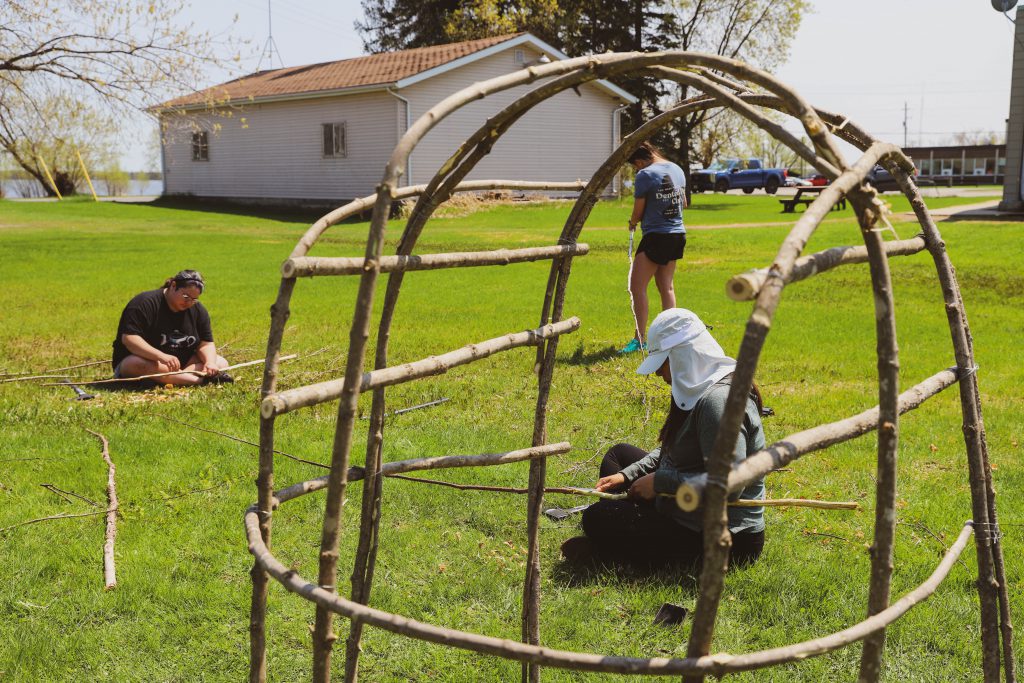Fish smoking huts, also known as giigoonagwaawaanaak in Anishinaabemowin, play an important role in the traditional practice of smoking fish among the Anishinaabeg. These huts are typically small, temporary shelters made of wooden frames covered with birch bark or other natural materials used for smoking and preserving fish.
The smoking hut serves as a means of preserving fish for future consumption, especially during times when fresh fish may not be readily available.
Materials needed
- Logs or sturdy wooden poles
- Birch bark or tarps
- Willow branches or flexible saplings
- Rocks or bricks for a fire pit
- Firewood or charcoal
- Mesh, wire racks or wooden poles for smoking
Process
Step 1: Select your site

Choose a suitable location for your smoking hut. Preferably away from flammable materials and in an area where smoke won’t be an issue.
Step 2: Prep your foundation
Clear the ground and level it as much as possible. You can use rocks or bricks to create a fire pit in the center of the hut.
Step 3: Construct the frame

Using logs or sturdy wooden poles, create a circular or rectangular frame for the hut. The height of the structure should allow for proper ventilation and hanging of the fish. The size of the hut depends on your needs but should be spacious enough to accommodate the quantity of fish you intend to smoke.
Step 4: Build your walls
Cover the frame with birch bark or tarps to create the walls of the smoking hut. Birch bark is traditional and ideal, but if it’s not available, you can use tarps or other waterproof materials. Secure the coverings.
Step 5: Create an entrance

Create an entrance in the smoking hut by leaving a gap in the wall covering. You can use birch bark or a tarp flap to serve as a door which can be secured.
Step 6: Assemble smoking racks

Inside the smoking hut, hang mesh or wire racks at different heights to place the fish. Willow branches or flexible wooden saplings can also be used to create the racks.
Step 7: Start smoking!



To smoke the fish, start a fire in the fire pit using firewood or charcoal. Once the fire is established and producing hot coals, place the fish on the racks inside the hut. The smoke from the fire will circulate and slowly cook and preserve the fish. Monitor the smoking process and adjust the fire with wood shavings as needed to maintain a consistent temperature. Be sure to follow safe food practices when smoking.
Knowledge, Connection and Preservation
Fish smoking huts often serve as communal spaces where knowledge and cultural practices are shared. Elders and community members come together to prepare and smoke fish, providing an opportunity for intergenerational learning and the transmission of cultural traditions. The construction and operation of fish-smoking huts involve a wealth of knowledge and skills that have been handed down from elders and ancestors.
Fish smoking huts represent a tangible connection to ancestral lands and the traditional fishing practices that have sustained communities for generations. The continued practice of fish smoking and the preservation of traditional knowledge associated with the huts are crucial for maintaining Anishinaabe cultural identity. By engaging in these activities, younger generations can learn about their heritage, values and traditional practices, ensuring that the cultural significance of fish-smoking huts endures.
Remember, it is essential to respect and understand the cultural significance of traditional practices like building a fish-smoking hut within the Anishinaabe community. If possible, seek guidance and knowledge from elders or community members to ensure you honour the traditions and values associated with the process.
Pursue culturally enriched education with SGEI
Seven Generation Education Institute (SGEI) is dedicated to excellence in lifelong learning and empowerment through language and Anishinaabe culture. We encompass traditional education by blending culture, tradition, information and technology at our Fort Frances, Kenora and Sioux Lookout campuses. Pursue your career while engaging in culturally enriched education with SGEI and apply to a college or university program today.
